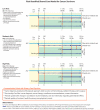Risk-based health care, the cancer survivor, the oncologist, and the primary care physician
- PMID: 24331199
- PMCID: PMC4465133
- DOI: 10.1053/j.seminoncol.2013.09.004
Risk-based health care, the cancer survivor, the oncologist, and the primary care physician
Abstract
Cancer survivors face substantial risks for morbidity, reduced quality of life, and premature mortality related to the cancer itself and/or the interventions undertaken to control cancer. Risk-based care that involves a personalized systematic plan of periodic screening, surveillance, and prevention relevant to the cancer experience is recommended to address the comprehensive health needs of the growing population of cancer survivors. Risk-based care and coordination between oncology and primary care providers have been identified as important metrics of quality cancer survivorship care. Various models of survivorship care, treatment summaries, and survivorship care plans have been promoted as methods to facilitate communication among providers across care transitions and improve survivor access to quality survivorship care. However, research supporting the feasibility of implementing these practices and their effectiveness in enhancing health outcomes is limited. This article reviews key concepts underpinning clinical and research initiatives endeavoring to improve access to quality care among long-term survivors and summarizes results of intervention studies implementing these elements in transitioning survivors from oncology to primary care providers for long-term follow-up care.
© 2013 Elsevier Inc. All rights reserved.
Figures

References
-
- Siegel R, DeSantis C, Virgo K, et al. Cancer treatment and survivorship statistics, 2012. CA Cancer J Clin. 2012;62:220–41. - PubMed
-
- Hewitt M, Greenfield S, Stovall E. From Cancer Patient to Cancer Survivor: Lost in Transition. The National Academies Press; Washington, DC: 2006.
-
- Hewitt M, Weiner SL, Simone JV. Childhood Cancer Survivorship: Improving Care and Quality of Life. The National Academies Press; Washington, D.C.: 2003. - PubMed
-
- Ganz PA, Earle CC, Goodwin PJ. Journal of Clinical Oncology update on progress in cancer survivorship care and research. J Clin Oncol. 2012;30:3655–6. - PubMed
-
- Earle CC, Burstein HJ, Winer EP, Weeks JC. Quality of non-breast cancer health maintenance among elderly breast cancer survivors. J Clin Oncol. 2003;21:1447–51. - PubMed
Publication types
MeSH terms
Grants and funding
LinkOut - more resources
Full Text Sources
Other Literature Sources

